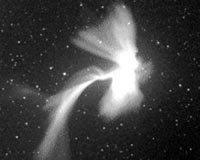 |
Lancaster, Wis. (UPI) Apr 15, 2010 A large meteor streaked over the U.S. Midwest Wednesday, briefly lighting up the night sky and unleashing a sonic boom heard for hundreds of miles. No injuries or damage were reported, but the ground, trees, homes and various objects, including wind chimes, shook from the boom's enormous amounts of sound energy, the National Weather Service said. The meteoroid, estimated at 6 feet in diameter and weighing at least 1,000 pounds, entered the Earth's atmosphere around 10:10 p.m. Central Daylight Time and was visible in Wisconsin, Iowa, Illinois and Missouri as a giant fireball flying eastward at an altitude of 6,000 to 12,000 feet, the National Weather Service reported. It may have landed intact in southwest Wisconsin, near Lancaster, or it may have broken into smaller pieces or burned up, the weather service said. No one reported seeing a meteorite or crater by late Thursday. A Howard County, Iowa, sheriff's deputy captured the fireball on video and posted it on the YouTube video-sharing Web site. "If something is bright enough to light up the sky like daytime and cause sonic booms throughout the entire area, it's big. It was major," astronomer Mark Hammergren of the Adler Planetarium in Chicago told National Geographic. "If it was daytime, people would have undoubtedly seen smoke trails," he said. While meteoroids entering the Earth's atmosphere are common, few pack the punch of Wednesday's fireball, University of Wisconsin Space Place Director James Lattis told the Wisconsin State Journal in Madison. And while some have suggested the fireball was part of a meteor shower, that is probably not true, Hammergren told National Geographic. The meteor was most likely a defector from the solar system's asteroid belt, a ring of space rocks and "minor planets" between the orbits of Mars and Jupiter, he said. The annual Lyrid meteor shower, observed annually for the past 2,600 years, is set to begin Friday and peak next Thursday.
Share This Article With Planet Earth
Related Links Asteroid and Comet Impact Danger To Earth - News and Science
 Shooting For Shooting Stars
Shooting For Shooting StarsPasadena CA (JPL) Apr 12, 2010 You know them as "shooting stars," or meteors. Space scientists know them as the fiery end of tiny visitors from space. Those momentary streaks of light across the night sky are nothing more than small to almost-microscopic pieces of space debris whose trip through the void has ended in a kamikaze run into Earth's atmosphere. Of course, with 100 tons of space rock and rubble bombarding the ... read more |
|
| The content herein, unless otherwise known to be public domain, are Copyright 1995-2010 - SpaceDaily. AFP and UPI Wire Stories are copyright Agence France-Presse and United Press International. ESA Portal Reports are copyright European Space Agency. All NASA sourced material is public domain. Additional copyrights may apply in whole or part to other bona fide parties. Advertising does not imply endorsement,agreement or approval of any opinions, statements or information provided by SpaceDaily on any Web page published or hosted by SpaceDaily. Privacy Statement |